Cr原子预覆盖S原子的Ni(111)表面对H2S解离吸附的第一性原理研究
IF 1.8
4区 化学
Q3 CHEMISTRY, PHYSICAL
引用次数: 0
摘要
本文采用第一性原理方法研究了Cr原子掺杂和S原子预覆盖对H2S在Ni(111)表面吸附解离的影响。Cr的掺杂增加了H2S的吸附强度,在预覆盖有S原子的表面上也是如此。此外,在干净的Ni(111)表面,Cr原子的引入促进了H2S的离解,导致了第二步离解反应的直接发生(Ea,2 = 0 eV)。S原子的预覆盖有利于H2S在Ni(111)表面的第一步解离,但抑制了第二步解离。随着Cr原子的加入,S原子抑制了H2S解离的两个步骤。这表明,在S原子存在的环境中,Cr原子的加入提供了一定程度的耐腐蚀性。本文章由计算机程序翻译,如有差异,请以英文原文为准。

First-principles study of the dissociative adsorption of H2S on the Ni(111) surface pre-covered with S atoms by Cr atoms
This article used first-principles methods to study the effects of Cr atom doping and S atom pre-coverage on the adsorption and dissociation of H2S on the Ni(111) surface. Cr doping increased the adsorption strength of H2S, which was also the case on surfaces pre-covered with S atoms. Additionally, on the clean Ni(111) surface, the introduction of Cr atoms promoted the dissociation of H2S and led to the direct occurrence of the second-step dissociation reaction (Ea,2 = 0 eV). The pre-coverage of S atoms can facilitate the first-step dissociation of H2S on the Ni(111) surface but inhibited the second-step dissociation. With the addition of Cr atoms, S atoms suppressed both steps of H2S dissociation. This demonstrated that in an environment where S atoms were present, the addition of Cr atoms provided a certain degree of corrosion resistance.
求助全文
通过发布文献求助,成功后即可免费获取论文全文。
去求助
来源期刊

Surface Science
化学-物理:凝聚态物理
CiteScore
3.30
自引率
5.30%
发文量
137
审稿时长
25 days
期刊介绍:
Surface Science is devoted to elucidating the fundamental aspects of chemistry and physics occurring at a wide range of surfaces and interfaces and to disseminating this knowledge fast. The journal welcomes a broad spectrum of topics, including but not limited to:
• model systems (e.g. in Ultra High Vacuum) under well-controlled reactive conditions
• nanoscale science and engineering, including manipulation of matter at the atomic/molecular scale and assembly phenomena
• reactivity of surfaces as related to various applied areas including heterogeneous catalysis, chemistry at electrified interfaces, and semiconductors functionalization
• phenomena at interfaces relevant to energy storage and conversion, and fuels production and utilization
• surface reactivity for environmental protection and pollution remediation
• interactions at surfaces of soft matter, including polymers and biomaterials.
Both experimental and theoretical work, including modeling, is within the scope of the journal. Work published in Surface Science reaches a wide readership, from chemistry and physics to biology and materials science and engineering, providing an excellent forum for cross-fertilization of ideas and broad dissemination of scientific discoveries.
 求助内容:
求助内容: 应助结果提醒方式:
应助结果提醒方式:


